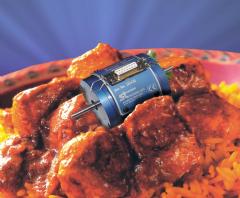 Add My Company
Add My Company
Sign In
FOOD RESEARCH ALL WASHED UP
06-01-2009

Real time process control for food manufacture has come a significant step closer, thanks to pioneering research work at University College Dublin into viscosity measurement techniques for characterising the flow and mixability of highly non-Newtonian fluids. At the heart of the researchers' experiments is the TorqSense transducer made by Sensor Technology in Oxon, which monitors the constantly changing flow characteristics of materials as diverse as tomato ketchup, chocolate, pasta sauce and chicken tikka massala as they are mixed.
Ireland's national economy has always had a strong agricultural element and more recently considerable value has been added to this by becoming one of Europe's foremost manufacturers of processed ingredients and ready meals.
Many foods are presented in a sauce or as what physicist could describe as a neo-liquid and can be produced in a process-type environment. But to date real time control has been virtually impossible due to the non-uniform nature of the food, which may contain particulates, fibres, vegetables, meat, nuts, raisins, biscuits etc.
"Real time process control is vital if food processors are to achieve the ultimate in product quality," says PJ Cullen, who leads the research team. "To achieve this the sensor has to be pretty special to detects the changes with sufficient sensitivity, yet be robust enough for regular wash-downs and general industrial abuse. Of course it must not compromise hygiene standards and regimes either.
We tried a number of sensors and TorqSense stood out as by far the best at meeting all our needs."
TorqSense uses Surface Acoustic Waves techniques to provide non-contact monitoring of instantaneous rotary torque, allowing accurate modelling of the instantaneous load changes. It is in effect a frequency dependent strain gauge operating at ultrasound frequencies and consists of a transducer mounted on the mixer's rotating shaft to monitors variations in its resonance frequency as the torsional load varies. An RF (radio frequency) link is used for wireless transmission of signals to an adjacent pick up so that rotation is unhindered.
PJ and his colleagues have simulated food processing techniques in a number of different laboratory rigs, one of the most used being a helical ribbon mixer similar to those employed by manufacturers for mixing ingredients together. Often the key requirement is to mix sufficiently to achieve a uniform dish, but not to waste time and energy by over-mixing.
"We do this by monitoring the torque on the mixer's shaft, as it will move to a steady state (within the characteristics of the given recipe) once fluid uniformity is achieved," says PJ.
TorqSense embraces all the advantages of SAW technology, including no load imparted to the drive mechanism under investigation, a broader signal bandwidth than other analogue based technologies and elimination of electronic interference.
"It has given us exactly what we needed at low cost, and it is simple to use and reliable - key requirements in a busy lab - but also very attractive to full scale process control environments," sums up PJ. "The only drawback of our research programme, is all the washing up after working so closely with so many different dishes all day!"
For more information on FOOD RESEARCH ALL WASHED UP talk to Sensor Technology Ltd
Enquire Now
More News
List your company on FindTheNeedle.

